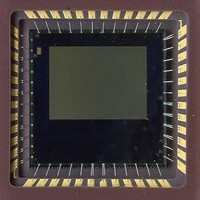CYIL1SM0300-EVAL Cypress Semiconductor Corp, CYIL1SM0300-EVAL Datasheet - Page 11

CYIL1SM0300-EVAL
Manufacturer Part Number
CYIL1SM0300-EVAL
Description
BOARD EVAL IMAGE SENSOR LUPA-300
Manufacturer
Cypress Semiconductor Corp
Specifications of CYIL1SM0300-EVAL
Sensor Type
CMOS Imaging, Monochrome
Sensing Range
VGA
Interface
SPI
Sensitivity
250 fps
Voltage - Supply
2.5 V ~ 3.3 V
Embedded
No
Utilized Ic / Part
LUPA-300
Lead Free Status / RoHS Status
Contains lead / RoHS non-compliant
Lead Free Status / RoHS Status
Lead free / RoHS Compliant, Contains lead / RoHS non-compliant
Synchronous Shutter
In a synchronous (snapshot or global) shutter light integration
takes place on all pixels in parallel, although subsequent readout
is sequential.
sequence for the synchronous shutter. All pixels are light
sensitive at the same period of time. The whole pixel core is reset
Non Destructive Readout (NDR)
The sensor can also be read out in a non destructive way. After
a pixel is initially reset, it can be read multiple times, without
resetting. The initial reset level and all intermediate signals can
be recorded. High light levels saturate the pixels quickly, but a
useful signal is obtained from the early samples. For low light
Note
Document Number: 001-00371 Rev. *F
6. This mode can be activated by setting the NDR SPI register. The NDR SPI register must only be changed during FOT. The NDR bit should be set high during
the first Frame Overhead Time after the pixel array is reset; the NDR bit must be set low during the last Frame Overhead Time before the pixel array is being reset.
Figure 10
shows the integration and read out
Line number
Figure 11. Principle of Non Destructive Readout
Integration time
Figure 10. Synchronous Shutter Operation
simultaneously and after the integration time all pixel values are
sampled together on the storage node inside each pixel. The
pixel core is read out line by line after integration. Note that the
integration and read out cycle can occur in parallel or in
sequential mode.
levels, one has to use the later or latest samples. Essentially an
active pixel array is read multiple times, and reset only once. The
external system intelligence takes care of the interpretation of
the
disadvantages of non destructive readout
data.
Burst Readout time
Table 12
[6]
summarizes
Time axis
time
CYIL1SM0300AA
the
advantages
Page 11 of 31
and
[+] Feedback










